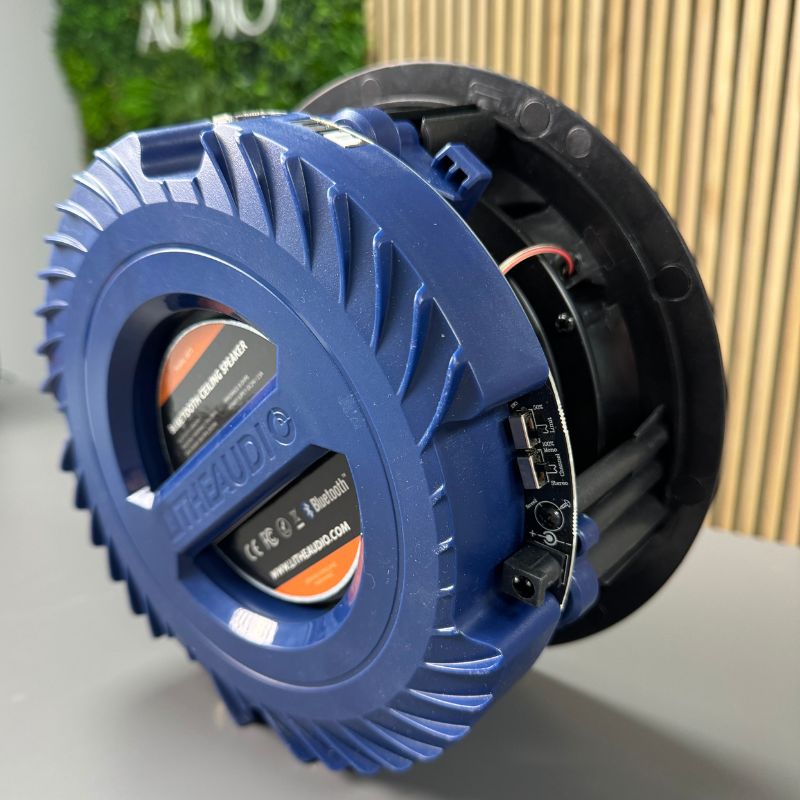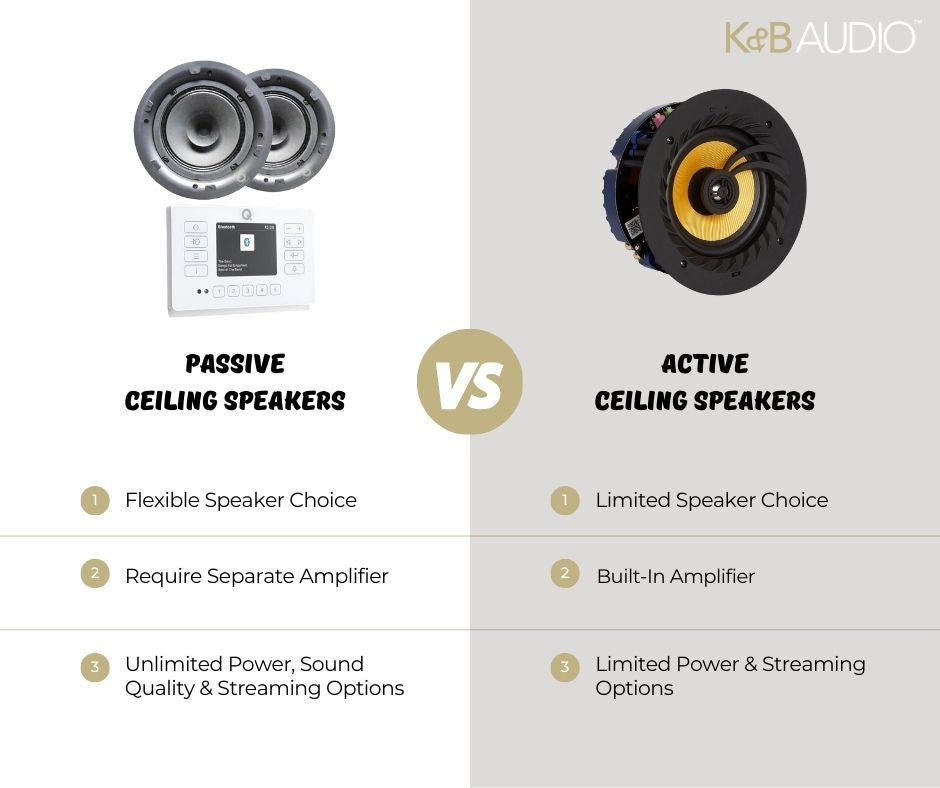The choice between active (powered) and passive ceiling speakers depends on various factors, including your specific audio setup, preferences, and the intended use of the speakers.
Here's a comparison to help you decide which may be the best option for your needs:
What are Active Ceiling Speakers?
Active ceiling speakers, also known as powered speakers or often referred to simply as Bluetooth ceiling speakers, come with an in-built amplifier.
This means they do not require an external amplifier or receiver to produce sound. They are designed to be directly connected to the sound source, which is typically from a built-in Bluetooth receiver.
The integrated amplifier in active speakers is specifically tailored to the speaker's drivers, ensuring optimal sound performance. This built-in amplifier also simplifies the setup process, as it eliminates the need for additional audio equipment.

Some advantages of active ceiling speakers are:
- Built-in Amplification: Active ceiling speakers have a built-in amplifier, eliminating the need for an external amplifier. This can simplify the installation process and reduce the overall system footprint.
- Ease of Installation: Active speakers are generally easier to install because you only need to connect them to a power source. This can be advantageous in situations where running speaker wires to an external amplifier is challenging like for instance when retrofitting into an existing room.
- Built-In Bluetooth: Most active ceiling speakers such as the Lithe Audio Bluetooth ceiling speakers come with a built-in Bluetooth receiver so you can simply connect your smart phone, tablet or computer and stream your favourite music without needing any additional equipment.
- Compact Design: Active speakers often have a more compact design since they don't require space for an external amplifier. This can be beneficial if you have limited space or want a discreet speaker installation.
The Drawbacks of Active Ceiling Speakers
Despite their advantages, active ceiling speakers also have some drawbacks.
Their main drawback is also the biggest selling point;
They are an all-in-one solution.
This means you cannot upgrade the amplifier, you can't make them louder, it's often difficult and expensive to run more than two speakers in a room and you can't easily connect TV's or add subwoofers.
If you just want good quality, easy to use music in your kitchen or bedroom though, this drawback actually becomes a big advantage!
They require a power source, which can complicate the installation process. You'll need to have access to a power socket near the installation site, or you'll need to run power cables through your ceiling to tap into the permanent live of your lighting circuit.
What are Passive Ceiling Speakers?
Passive ceiling speakers, on the other hand, do not have a built-in amplifier.
Instead, they rely on an external amplifier or receiver to power them. This means that you'll need to connect the speakers to an amplifier using speaker cables.
While this might seem like an extra step, it also gives you more flexibility. You can choose an amplifier that matches your specific needs and preferences, and you can upgrade or change the amplifier without having to replace the entire speaker.
Read More: Do Ceiling Speakers Need An Amplifier

Some advantages of passive ceiling speakers are:
- Flexibility & Customisation: Passive speakers offer more flexibility in terms of amplifier selection. You can choose an amplifier that matches your specific requirements in terms of power, features, and brand preferences.
- Scalability: Passive speaker systems are often more scalable. You can easily expand the system by adding more speakers without the need for additional built-in amplifiers. This can be useful in larger installations or when integrating with existing audio setups.
- Separate Components: Some users prefer the modular nature of passive systems, where the amplifier is a separate component. If one part of the system needs an upgrade or replacement, it can be done without affecting the other components.
- Potential for Higher-End Audio: Audiophiles may prefer passive systems for the ability to choose high-quality, dedicated amplifiers and speakers that can provide optimal performance. This is especially true for high-end audio setups where precise control over amplifier characteristics is desired.
The Drawbacks of Passive Ceiling Speakers
Like active speakers, passive ceiling speakers also have their drawbacks.
One of the main ones is that they require an external amplifier.
This means you'll need to find an amplifier that matches the speaker's power requirements and locate it somewhere within the room you are installing ceiling speakers into.
Passive speakers also require more cables than active speakers. You'll need to run speaker cables from the amplifier to each speaker, which can lead to a more complicated installation process.
We've created a large amount of ready-to-install ceiling speaker system bundles to make the decision much easier for you.
Which Is Better?
When it comes to choosing between active and passive ceiling speakers, there's no one-size-fits-all answer.
The best choice depends on your specific needs, preferences, and circumstances:
- If you value simplicity and ease of installation, then active ceiling speakers might be the best choice for you.
- On the other hand, if you prefer to have more control over your audio system with higher quality amplifiers & speakers then passive ceiling speakers might be a better fit.
If you want to answer the question factually then passive speakers with an amplifier is much better as you can fine tune the power and sound quality to your hearts content, but you'll pay for it.
From my 10 years experience in selling ceiling speakers systems we'd suggest that you first look at what you're trying to achieve and work up from there.
Good background music in the kitchen? Active speakers will be great.
Four speakers with high sound quality and a subwoofer? Passive speakers + amplifier will be a much better shout.
So, both systems are great and both have their pros and cons.

Conclusion
Ultimately, the decision between active and passive ceiling speakers is a personal one.
By understanding the strengths and weaknesses of each type of speaker, you can make an informed decision that best suits your needs.
Carefully consider your needs, the available space, and your budget when making a decision between active and passive ceiling speakers.
We're on hand to help you make this decision via email, live chat or by calling 02392 190955.





